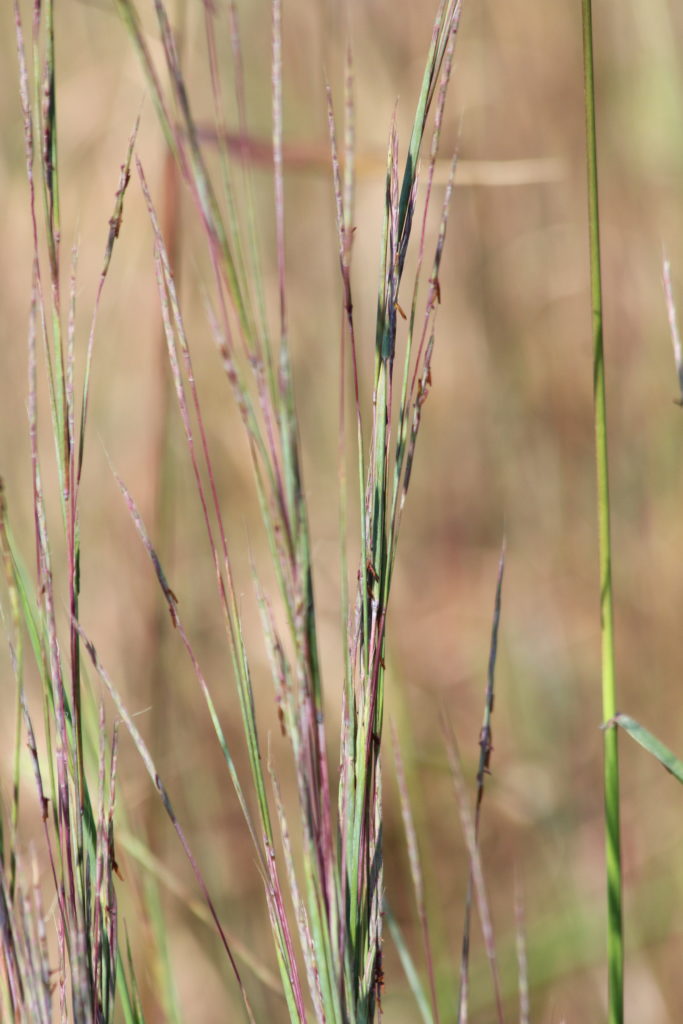
What’s In Bloom | Little Bluestem
- Little Bluestem (Schizachyrium scoparium) is a perennial warm-season bunchgrass native to most of Canada and the United States.
- 2-4 feet tall, with blue-green leaves which turn reddish brown during fall and winter.
- Requires full sun; prefers infertile soils with varying textures, from sand to clay to gravel.
- Of high value to wildlife, providing food and habitat through its leaves and seeds.

Little Bluestem (Schizachyrium scoparium) is a perennial warm-season bunchgrass native to southern Canada and most of the United States. Typically growing 2-4 feet tall, its base, up to 1 foot in diameter, is densely tufted with blue-green leaves, whose colors are the source of its common name. The leaves are up to 10 inches long and ½ inch wide, sometimes pubescent (hairy) but usually hairless, and grow alternately along the lower half of each culm1. The finely veined leaf sheaths wrap tightly around the culm and form a “V” along the front of it. The culm is erect and blue-green, and nodes are purplish and swollen. In autumn, leaves and culms take on various shades of beautiful reds, tans, and browns which remain throughout winter.
Little Bluestem flowers for around 2 weeks in late summer-autumn. Spikelets2 occur opposite each other along a rachis (central stalk), which is covered in long white hairs. Florets are cross-pollinated by the wind, and each spikelet forms 1 seed, which is purplish, spindle-shaped and tapers to a narrow tip. Eventually, spikelets fall off and are dispersed by the wind, to some extent.

Little Bluestem prefers infertile dry-mesic soils of varying textures, including clay, gravel, and sand. Habitats include hill, gravel, sand, black soil, and clay prairies, scrubby barrens, rocky slopes, sandy savannas, sand dunes, gravelly areas along railroads, and abandoned fields. It is commonly used in prairie and meadow restorations. With its beautiful fall color and tufted seedheads, plus its high value to wildlife, it provides both visual beauty and habitat.
Benefits to biodiversity | Little Bluestem is of great use to wildlife. Caterpillars of many Skipper species, including Indian, Cobweb, and Swarthy Skippers, feed on the leaves. Grasshoppers, beetles, and others also feed on the foliage, and they provide an important food source for insectivorous birds. Various seed-eating songbirds and small mammals use the seeds as an important food source throughout winter. It is also palatable to grazing mammalian herbivores. Bunchgrasses in general provide space for pathways used by small animals including quail, ground-nesting songbirds, and small mammals. For safe overwintering, Queen Bees, caterpillars, and small mammals may utilize the protected space at the base of the clumps.
- Culm: central axis of the mature grass shoot, comprised of nodes and internodes; each node bearing a leaf. (Oregon State)
- Spikelet: a flowering unit comprised of one or more florets enclosed by two glumes (bracts). (Oregon State)

Sources:
https://forages.oregonstate.edu/regrowth/how-does-grass-grow/grass-structures
https://www.minnesotawildflowers.info/grass-sedge-rush/little-bluestem
https://www.wildflower.org/plants/result.php?id_plant=SCSC
https://www.illinoiswildflowers.info/grasses/plants/little_bluestem.htm